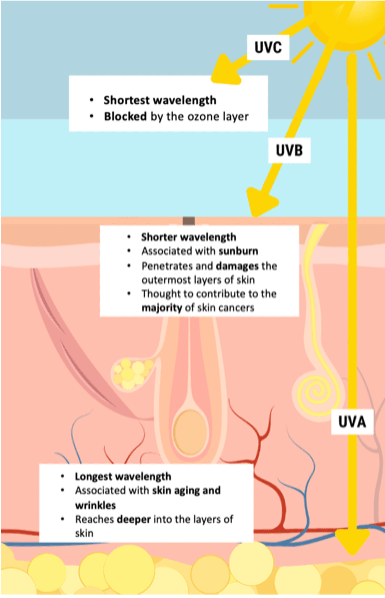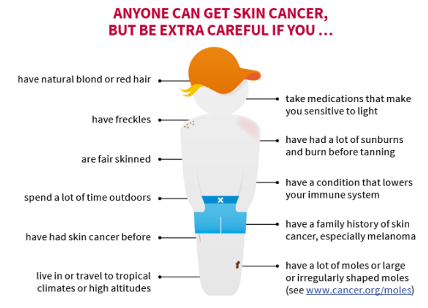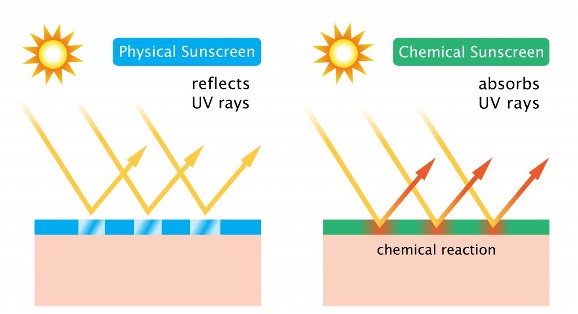By Carli King
Here comes the sun… and the sunburn! With the start of summer upon us, it is extra important to understand the benefits and risks of sunshine. A major physiological benefit of sunlight is it stimulates the production of vitamin D in the body, which is essential for the absorption of crucial minerals like calcium and phosphorous1,2. Sunlight can also offer a mood boost as exposure to sunlight and is thought to increase the brain’s release of serotonin, which is associated with mood and cognition, amongst many other functions3. In fact, days with plentiful sunshine are associated with better mental health and a greater impact on mood than any other environmental factor3. However, there are many risks associated with spending too much time in the sun, resulting in overexposure to ultraviolet (UV) radiation. While it is impossible (and unhealthy) to totally avoid the sun, there are many ways to be sun-safe and continue to have fun in the sun. Sun safety can include understanding and limiting your risk of UV exposure and having an appropriate sun safety strategy (not limited to sunscreen!).
How much sun is too much sun?
The sun produces three main types of electromagnetic radiation: infrared radiation, visible light, and UV radiation. Unlike infrared radiation that we can feel (temperature) and visible light that we can see (sunshine), UV radiation cannot be seen or felt, leaving us vulnerable to prolonged UV radiation exposure4, as there is no way to naturally “tell” how much is too much. There are three types of UV radiation: UVA, UVB, and UVC. While UVC rays have the highest energy level of the three, they are absorbed completely by the ozone layer and cannot reach the earth’s surface. On the other hand, UVA and UVB can transmit through the earth’s atmosphere, and they therefore often contribute to skin cancer pathogenesis, sunburn, eye damage, and skin aging4 (Figure 1). UVA rays account for 95% of the UV rays from the sun that reach the ground5. UVA rays have the least energy amongst the UV rays and can cause indirect damage to skin cells, leading to long-term damage such as wrinkles and skin aging5. The remaining 5% of UV rays that reach the ground are UVB rays5. UVB rays have more energy than UVA rays and can damage DNA in skin cells directly, cause sunburns, and are thought to cause the majority of skin cancers5.

Most skin cancers, including basal and squamous cell skin cancer and melanoma of the skin5, are a result of UV exposure. Basal and squamous cell skin cancer is very common, very treatable, and most often found in areas that receive increased sun exposure (i.e. the head, neck, and arms)6. Melanoma of the skin, while less common and more serious, has also been linked to increased sun exposure7. Regular self-exams of the skin as well as formalized dermatology appointments are especially crucial for those at a higher risk of skin cancer, including individuals that spend significant time outside5. Learn how to perform regular skin self-exams here.
In addition to increasing risk of skin cancer, overexposure to UV rays can cause additional unwanted symptoms, such as: sunburn; premature aging of the skin; eye damage including cataracts (clouding of the lens of the eye); and pterygium (tissue growth on the surface of the eye) that leads to impaired vision, and a weakened immune system5. Despite the risks, everyone under the sun deserves to enjoy the warm weather and sunshine! To safely enjoy your time in the sun, make sure you know your UV exposure risk and have a sun protection strategy.
How can you protect your skin from the sun?
1. Understanding your risk for UV exposure
UV ray strength varies based on a number of factors, including time of the day, season of the year, distance from the equator, altitude, clouds, and reflection off surfaces. UV rays are strongest between 10 AM and 4 PM during the spring and summer months and at higher elevations5. While the effect of clouds on UV exposure can differ greatly, it is most important to note that you can still be exposed to UV rays on cloudy days5. The reflection from surfaces is often overlooked as a contributing factor; however, this kind of reflection, such as off of water or snow, can lead to an increase in UV exposure5. Luckily, there are resources available to help you understand your UV exposure risk on any given day. The UV Index scale (1-11+) is a great way to gain an understanding of what your local UV exposure is forecasted to be, with higher numbers correlating to a higher risk of harmful exposure to UV radiation (Figure 2). You can find your UV Index daily forecast here or on your favorite weather app.
In general, the UV Index scale guidelines are:
0 – 2: low risk with minimal sun protection
3 – 7: moderate to high risk with sun protection needed
8+: very high to extreme risk with extra sun protection needed8
No matter the number you see on your local UV index scale, it is still important to take precautions to protect your skin (and your eyes) from the sun.
Everyone is at risk of harmful health effects from UV exposure, including sunburn or skin cancer; however, some individuals are at an increased risk (Figure 3). Those at an increased risk includes people who:
- Spend the majority of the day in the sun (i.e. individuals who work outside)
- Have had previous sunburns or tend to burn before tanning9
- Have light-colored skin, hair, and eyes1
- Have freckles9
- Live in, or travel frequently to, areas with warm climates and/or high altitudes9
- Take certain oral or topical medications that make you sensitive to light1
- Have had skin cancer previously or have a family history of skin cancer1,9
- Are over the age of 501

2. Having a sun protection strategy
Sun protection is important every day of the year, regardless of the season. Simple ways to limit your exposure UV rays include:
- Staying in the shade when possible (especially during midday hours when UV exposure is highest).
- Protecting your skin by wearing clothing that covers your arms and legs, as well as wearing a hat.
- Some companies even make sun-protective clothes with the label listing “UV protection factor (UPF)” with higher numbers correlating to higher protection8.
- Wearing sunglasses to protect your eyes.
- Ideally, sunglasses should block 99 – 100% of UVA and UVB rays and their labels should read “UV absorption up to 400 nm” or “Meets ANSI UV Requirements.10” Unfortunately, sunglasses labeled as cosmetic only block about 70% of UV rays10.
- Using sunscreen (all year round).
- Sunscreen acts as a filter, not a blocker of all UV rays; therefore, it is important to understand that even with perfect use of sunscreen, some UV rays will still reach your skin.
Not all sunscreens are created equal, and it is important to read the label to understand the level of protection you are receiving. So, what should you look for in a sunscreen?
- Sun protection factor (SPF) is the level of protection the sunscreen provides against UVB rays (Figure 4).
- When wearing SPF 30 sunscreen, applied correctly, you get 1 minute of UVB rays for each 30 minutes spent in the sun10. It is recommended to wear at least SPF 30 sunscreens as they filter out approximately 97% of UVB rays10.
- Broad spectrum sunscreens are those that have been tested to protect against UVA and UVB rays.
- Water resistant sunscreens will state whether they protect the skin for 40 or 80 minutes of swimming or sweating10.
- Expiration date should be checked to be sure the sunscreen is effective. Most sunscreens are good for 2 to 3 years.
- Active ingredients lists can help you determine whether your sunscreen is a physical/mineral (titanium dioxide and zinc oxide) or a chemical filtering sunscreen (i.e. avobenzone, homosalate, octocrylene, octinoxate, octisalate, and oxybenzone)11.
- Physical or mineral sunscreen ingredients work as a reflective barrier to scatter UV rays, while chemical sunscreen ingredients create a chemical reaction that helps prevent UV damage11 (Figure 5).
- Notably, some chemical ingredients (including the previously mentioned avobenzone, oxybenzone, and octocrylene, amongst others) have been called into question and require additional testing. In general, titanium dioxide and zinc oxide are considered safe by the Food and Drug Administration (FDA) and recommended by dermatologists11.


There are many reasons to enjoy the sunshine, from mental health benefits to physical health benefits. However, it is crucial to understand the risks of too much sunshine and overexposure to UV radiation. After all, it is all sun and games until someone gets a sunburn!
TL:DR
- The sun emits ultraviolet (UV) radiation in the form of UVA, UVB, and UVC rays. However, only UVA and UVB contribute to skin cancer pathogenesis, sunburn, eye damage, and skin aging.
- You should protect yourself from the sun all year round by checking the UV Index and having a sun protection strategy: stay in the shade, wear protective clothing, and wear sunscreen.
- Not all sunscreens are created equal. Look for broad spectrum sunscreens with SPF 30+ and consider other factors, such as water resistance and active ingredients.
References
- Centers for Disease Control and Prevention: National Center for Environmental Health. “UV Radiation.” July 5, 2022. https://www.cdc.gov/nceh/features/uv-radiation-safety/index.html#:~:text=Ultraviolet%20(UV)%20radiation%20is%20a,The%20sun
- McNeill, Anne Marie and Wesner Erin. Skin Cancer Foundation. “Sun Protection and Vitamin D.” March 14, 2019. https://www.skincancer.org/blog/sun-protection-and-vitamin-d/#:~:text=When%20your%20skin%20is%20exposed,active%20form%20of%20vitamin%20D.
- Tri-City Medical Center. “5 Ways the Sun Impacts Your Mental and Physical Health.” https://www.tricitymed.org/2018/08/5-ways-the-sun-impacts-your-mental-and-physical-health/#:~:text=Getting%20some%20sun%20increases%20your,in%20combination%20with%20other%20treatments.
- Cancer Council NSW. “What is UV radiation?” https://www.cancercouncil.com.au/cancer-prevention/sun-protection/understanding-uv-radiation/what-is-uv-radiation/
- American Cancer Society. “Ultraviolet (UV) Radiation.” July 10, 2019. https://www.cancer.org/cancer/risk-prevention/sun-and-uv/uv-radiation.html
- American Cancer Society. “Basal and Squamous Cell Skin Cancer.” https://www.cancer.org/cancer/types/basal-and-squamous-cell-skin-cancer.html
- American Cancer Society. “Melanoma Skin Cancer.” https://www.cancer.org/cancer/types/melanoma-skin-cancer.html
- United States Environmental Protection Agency. “UV Index Scale.” June 5, 2023. https://www.epa.gov/sunsafety/uv-index-scale-0
- American Cancer Society. “Preventing Skin Cancer.” May 2021. https://www.cancer.org/cancer/risk-prevention/sun-and-uv/skin-cancer-prevention-infographic.html
- American Cancer Society. “How do I protect myself from ultraviolet (UV) rays?” July 23, 2019. https://www.cancer.org/cancer/risk-prevention/sun-and-uv/uv-protection.html
- Cleveland Clinic. Health Essentials. “How to pick the best sunscreen, according to a dermatologist.” July 26, 2022. https://health.clevelandclinic.org/how-to-choose-the-best-sunscreen-for-your-skin/
